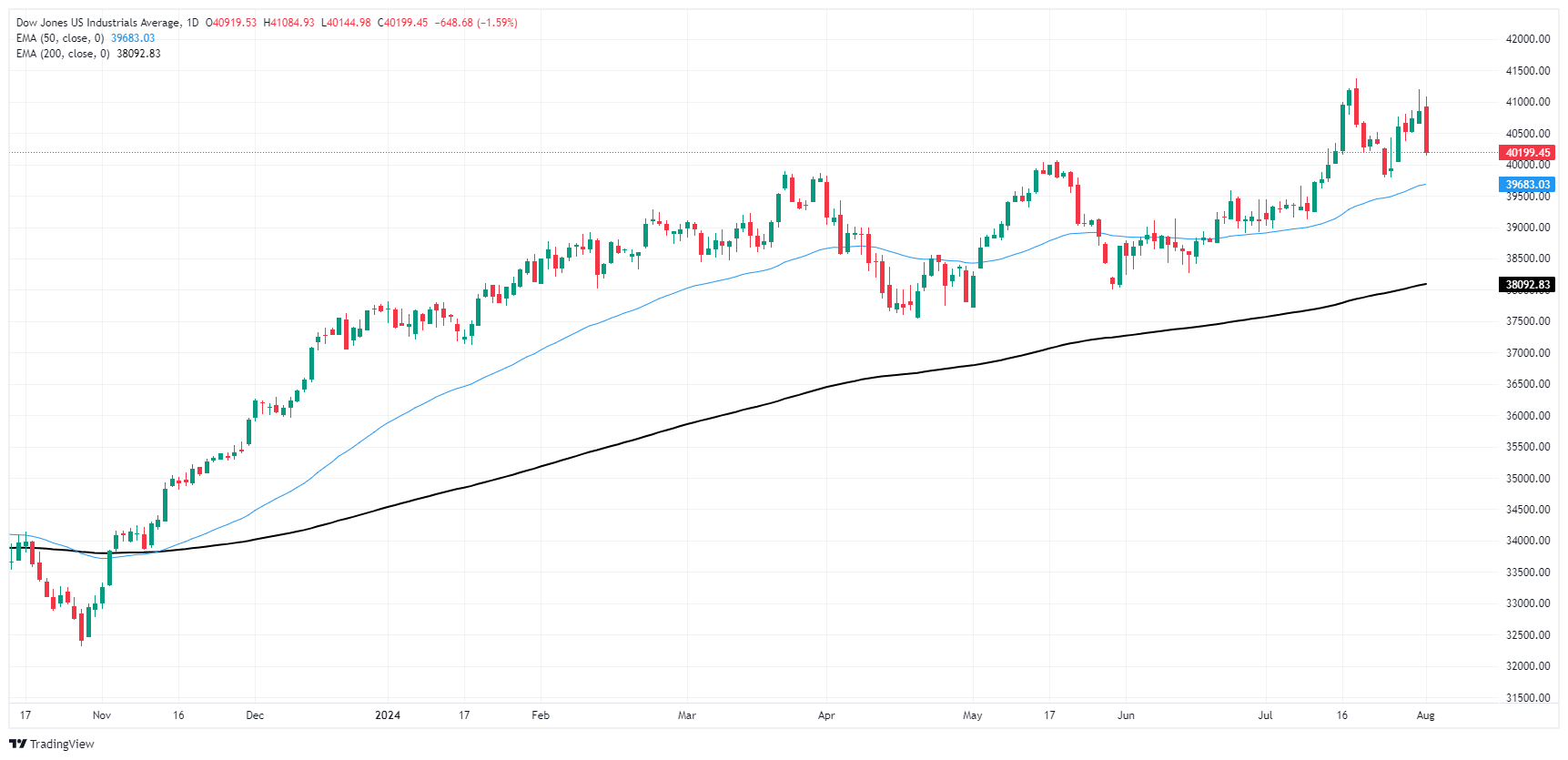- The Dow Jones fell after a miss in US PMI activity figures on Thursday.
- Concerns about a worsening economic slowdown have dampened risk appetite.
- Markets are struggling to balance hopes for rate cuts with economic realities.
The Dow Jones Industrial Average (DJIA) plunged 700 points on Thursday after economic activity numbers worsened, reminding markets of the very real risk that a slowdown in the U.S. economy could lead to a hard landing scenario. Short-term gains sparked by rising hopes for interest rate cuts faded as investors struggle to balance their hopes that weak data will trigger a new rate-cutting cycle by the Federal Reserve (Fed) and the fact that that same weak data could trigger a full-blown recession, making rate cuts a moot point.
US Initial Jobless Claims for the week ended July 26 rose to 249K from 235K the previous week, beating the expected rise to 236K.000. US ISM Manufacturing Purchasing Managers’ Index (PMI) in July fell to an eight-month low of 46.8 compared to 48.5 previously, completely reversing the expected move towards 48.8.
On the other hand, ISM manufacturing prices paid in July accelerated to 52.9 from 52.9 previously compared with the forecast of 48.8, as input prices for manufacturers continue to drift higher than markets had anticipated, even as activity slows.
US Non-Farm Payrolls (NFP) on Friday will be a key data point for markets to close out the trading week. July employment figures are expected to decline to 175,000 from 206,000 previously, and average hourly earnings are expected to remain flat at 0.3% monthly.
Markets are struggling to balance on a very sharp razor’s edge as a slowdown in economic numbers is helping to further set rate cut expectations at the ceiling. According to the CME’s FedWatch tool, rate traders are pricing in a 100% chance of at least a quarter-point rate cut by the Fed on Sept. 18, with an additional one-in-five chance of a 50-basis-point double cut. On the downside, too much of a slowdown will destroy market sentiment as a hard landing scenario for the U.S. economy makes any rate cuts by the Fed irrelevant, and investors are in a difficult terrain where they expect rate cuts on weak data, but not so weak that the U.S. economy slumps.
Dow Jones News
Four-fifths of the stocks listed on the Dow Jones Industrial Average are in the red Thursday as investor sentiment sours. Boeing Co. (BA) fell -5.8% to $180.00 a share on the day, extending Wednesday’s declines after the aviation company reported a second-quarter net loss of $1.4 billion, and the ailing aircraft maker is struggling to find its bearings after naming a new CEO to lead the struggling company whose accounts are collapsing under the weight of a half-decade of financial losses.
Dow Jones Technical Outlook
The Dow Jones is struggling to find a foothold amid strong selling pressure on Thursday, falling from 41,080.00 to 40,200.00, declining -2.56% from Wednesday’s late peak near 41,200.00 and losing around 700 points.
Despite the near-term downward pressure, the major equity index remains trading deep in bullish territory, holding north of the 50-day EMA at 39,682.22. The Dow Jones has traded above the 200-day EMA in an extended rally untouched since crossing above the long-term average in November last year.
Dow Jones daily chart
Economic indicator
ISM manufacturing PMI
He Institute for Supply Management (ISM) The US Manufacturing Index (USMI) releases the manufacturing index, which reflects business conditions in the US manufacturing sector, taking into account expectations for future production, new orders, inventories, employment and deliveries. It is a significant indicator of overall US economic activity. A reading above 50 points indicates expansion in economic activity, while a reading below 50 points implies a decline in activity. A reading above expectations is bullish for the dollar, while a reading below consensus is bearish.
Latest Post: Thu Aug 01, 2024 14:00
Frequency: Monthly
Current: 46.8
Dear: 48.8
Previous: 48.5
Fountain: Institute for Supply Management
The Institute for Supply Management (ISM) Manufacturing Purchasing Managers’ Index (PMI) provides a reliable perspective on the state of the US manufacturing sector. A reading above 50 suggests that business activity expanded during the survey period and vice versa. PMIs are considered leading indicators and could signal a turn in the business cycle. Stronger than expected results generally have a positive impact on the USD. In addition to the headline PMI, the employment index and prices paid index numbers are closely watched as they shed light on the labor market and inflation.
Source: Fx Street
I am Joshua Winder, a senior-level journalist and editor at World Stock Market. I specialize in covering news related to the stock market and economic trends. With more than 8 years of experience in this field, I have become an expert in financial reporting.







